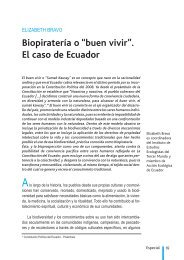BIOPIRACY Imitations Not Innovations - Biopirateria
BIOPIRACY Imitations Not Innovations - Biopirateria
BIOPIRACY Imitations Not Innovations - Biopirateria
Create successful ePaper yourself
Turn your PDF publications into a flip-book with our unique Google optimized e-Paper software.
Biopiracy: <strong>Imitations</strong> <strong>Not</strong> <strong>Innovations</strong> 15<br />
Partly as a result of these well-known cases, developing countries, holders of<br />
traditional knowledge, and campaigning organizations are pressing in a multitude<br />
of fora for IK to be better protected. Challenging patents granted on indigenous<br />
knowledge is not a solution to the problem because generally such patents go<br />
unnoticed and secondly, challenging such patents in foreign nations is expensive<br />
and time-consuming, which is a major problem for resource-poor developing<br />
nations. The solution to this problem must lie in action on the part the ‘offending’<br />
nations, they should amend their intellectual property regimes so as to protect<br />
and recognize IK.<br />
This situation calls for the regulation of access to bioresources and associated<br />
IK. A mandatory regulation of access to bioresources and associated knowledge<br />
according to the provisions of the Convention on Biodiversity (CBD) and other<br />
pro-community international agreements is a necessity to prevent the incidence<br />
of biopiracy. Such regulation would involve the consent of the rural and indigenous<br />
communities in cases where biological resources and/or knowledge are accessed.<br />
As a corollary to this regulation, it would also involve benefit-sharing (monetary<br />
and/or non-monetary) with these communities in the benefit accruing out of<br />
the use of biological resources and associated IK.<br />
In the wake of the advances in biotechnology and the extension of patent<br />
protection to living organisms, both developed and developing countries realized<br />
the importance of regulating access to bioresources. This was the basis for the<br />
conclusion of the CBD in 1992. The Convention on Biological Diversity, 1992,<br />
inter alia, recognizes the sovereign rights of States over their biological resources; the<br />
close and traditional dependence of many indigenous and local communities<br />
embodying traditional lifestyles on biological resources; the desirability of sharing<br />
equitably benefits arising from the use of traditional knowledge; and innovations<br />
and practices relevant to the conservation of biological diversity and the sustainable<br />
use of its components. Article 8(j) of the CBD provides that “Each contracting<br />
party shall, as far as possible and as appropriate, subject to its national legislation,<br />
respect, preserve and maintain knowledge, innovations and practices of indigenous<br />
and local communities embodying traditional lifestyles relevant for the conservation<br />
and sustainable use of biological diversity and promote their wider application<br />
with the approval and involvement of the holders of such knowledge, innovations<br />
and practices and encourage the equitable sharing of the benefits arising from<br />
the utilization of such knowledge, innovations and practices”. Further, Article<br />
15 of the CBD lays down provisions for the access of genetic resources, according<br />
to which access is subject to Prior Informed Consent (PIC) from the donor state<br />
on Mutually Agreed Terms (MAT) between donor and recipient. It also requires



